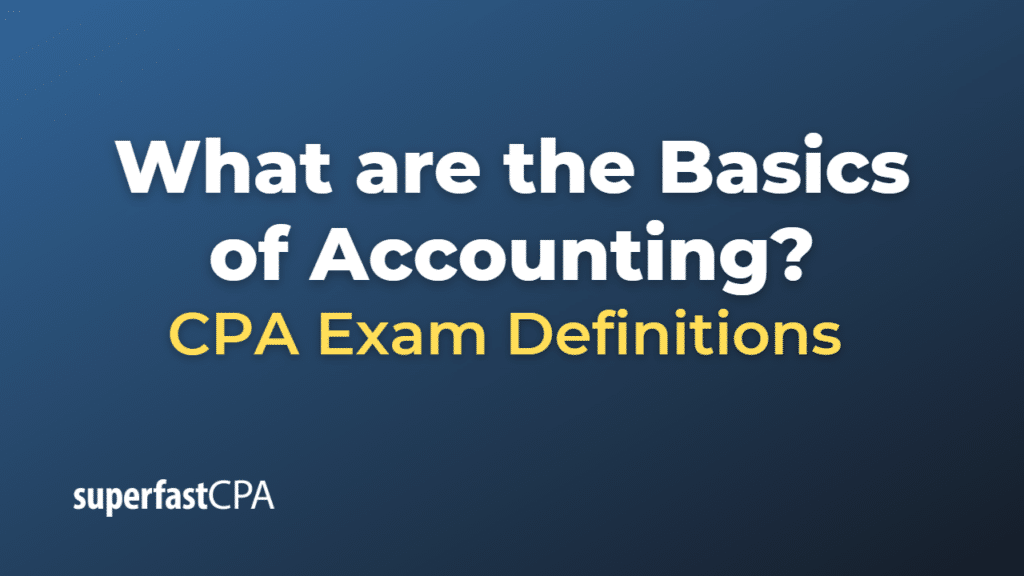Basics of Accounting
The basics of accounting involve a set of concepts, principles, and procedures that help businesses systematically record, report, and analyze their financial transactions. Understanding these basics is crucial for accurate financial reporting and informed decision-making. Here are some of the key elements of accounting basics:
- Double-entry bookkeeping: This system requires that every financial transaction be recorded in at least two accounts: one as a debit and the other as a credit. The total amount of debits must always equal the total amount of credits, ensuring that the accounting equation (Assets = Liabilities + Owner’s Equity) remains in balance.
- Chart of accounts: This is a structured list of all the accounts used by a business to record financial transactions. The chart of accounts is organized into categories such as assets, liabilities, owner’s equity, revenues, and expenses.
- Journal entries: Financial transactions are initially recorded in chronological order as journal entries. Each entry includes the date, a description of the transaction, and the debit and credit amounts for the affected accounts.
- Ledgers: A ledger is a collection of accounts where the transactions from journal entries are summarized and posted. Ledgers help businesses track the balances of individual accounts and prepare financial statements.
- Trial balance: A trial balance is a report that lists the balances of all ledger accounts. It is prepared periodically to ensure that the total debits equal the total credits, indicating that the accounts are in balance.
- Financial statements: These are formal reports that summarize a company’s financial performance and position. The primary financial statements include the balance sheet, income statement, and cash flow statement.
- Accrual accounting: Under this method, revenues are recognized when they are earned, and expenses are recognized when they are incurred, regardless of when cash is exchanged. Accrual accounting provides a more accurate picture of a company’s financial position and performance.
- Basic accounting principles: These are the fundamental guidelines and concepts that govern the practice of accounting, ensuring consistency, reliability, and comparability of financial information. Key principles include the accrual basis, economic entity assumption, monetary unit assumption, time period assumption, cost principle, revenue recognition principle, matching principle, and full disclosure principle.
- Adjusting entries: These are journal entries made at the end of an accounting period to allocate revenues and expenses to the correct time periods and update account balances accordingly. Adjusting entries ensure that financial statements comply with the accrual basis of accounting and accurately reflect the company’s financial position.
- Closing entries: These entries are made at the end of an accounting period to reset the temporary revenue and expense accounts to zero and transfer their balances to the owner’s equity or retained earnings account. This process prepares the accounts for the next accounting period.
Understanding and applying these accounting basics is essential for maintaining accurate and reliable financial records, which are the foundation for informed decision-making by business owners, investors, creditors, and other stakeholders.
Example of the Basics of Accounting
Let’s use a fictional example of a small business called “Mike’s Bike Shop” to demonstrate some of the basics of accounting in action.
- Double-entry bookkeeping: Mike’s Bike Shop purchases a new bike for $500 to sell in their store. The transaction is recorded in two accounts: Inventory (Asset) is debited by $500, and Accounts Payable (Liability) is credited by $500.
- Chart of accounts: Mike’s Bike Shop has a chart of accounts that includes categories such as Cash, Accounts Receivable, Inventory, Accounts Payable, Owner’s Equity, Sales Revenue, and Expenses (Rent, Utilities, Salaries).
- Journal entries: When Mike’s Bike Shop sells a bike for $800 on credit, a journal entry is made:
- Debit Accounts Receivable: $800
- Credit Sales Revenue: $800
- Ledgers: Mike’s Bike Shop maintains ledgers for each account, such as Cash, Inventory, and Sales Revenue. The transactions from journal entries are posted to these ledgers, allowing Mike to track the account balances.
- Trial balance: At the end of the month, Mike prepares a trial balance to ensure that the total debits equal the total credits, verifying that the accounts are in balance.
- Financial statements: Mike’s Bike Shop prepares financial statements, including the balance sheet, income statement, and cash flow statement, to assess its financial performance and position.
- Accrual accounting: Mike’s Bike Shop recognizes revenue when a bike is sold and expenses when they are incurred, regardless of when cash is received or paid. This method provides a more accurate picture of the company’s financial performance.
- Basic accounting principles: Mike’s Bike Shop follows basic accounting principles such as the accrual basis, economic entity assumption, monetary unit assumption, and others to ensure consistency and comparability of its financial information.
- Adjusting entries: At the end of the month, Mike’s Bike Shop makes adjusting entries to allocate revenues and expenses to the correct periods, ensuring that the financial statements accurately reflect the company’s financial position.
- Closing entries: Mike’s Bike Shop makes closing entries to reset temporary revenue and expense accounts to zero and transfer their balances to the retained earnings account, preparing the accounts for the next accounting period.
By applying these accounting basics, Mike’s Bike Shop can maintain accurate and reliable financial records, which are essential for informed decision-making, performance evaluation, and compliance with financial reporting standards.













